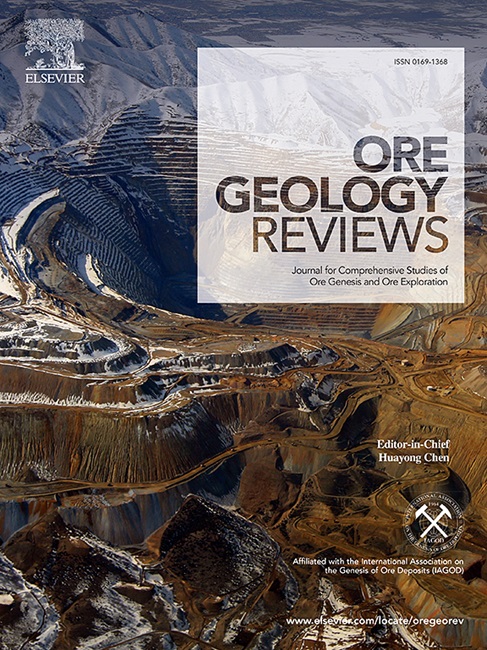Assessment of gold endowment and exploration maturity in selected South African goldfields using Zipf’s law, deposit density regression, and the USGS three-part quantitative mineral resource assessment: Toward sustaining gold production
IF 3.2
2区 地球科学
Q1 GEOLOGY
引用次数: 0
Abstract
South Africa hosts multiple Archean- to Proterozoic-aged goldfields, but its current gold production comes mainly from three terranes (i.e., Witwatersrand Goldfields, Amalia–Kraaipan Greenstone Belt and Barberton Greenstone Belt). A recent study indicated the potential depletion of reserves due to future production, lower resource-to-reserve conversion, and lack of exploration programs to delineate new resources. Aiming to encourage exploration activities and to sustain gold production, we assessed potential residual gold resource endowment, estimated the number of undiscovered gold deposits, and quantified exploration maturity within the selected goldfields using Zipf’s Law, the deposit density regression (DDR) technique, and the USGS three-part quantitative mineral resource assessment (3-part QMRA). Based on Zipf’s curve, the Sabie–Pilgrim’s Rest Goldfield (SPRG) is the most exploration-mature geologically-permissive tract (∼68 %) with residual ore tonnages of at least 8.29 Mt (in 11 deposits > 0.50 Mt), followed by the Murchison (MGB) (∼45 %), Pietersburg (PGB) (∼45 %) and Amalia–Kraaipan Greenstone Belts (AKGB) (∼43 %) with residual ore tonnages of 2.17 Mt (in 3 deposits > 0.60 Mt), 1.01 Mt (in 5 deposits > 0.05 Mt) and 477 Mt (in 13 deposits > 10 Mt), respectively. The DDR demonstrated that the AKGB and PGB have at least 1 undiscovered gold deposit at the 90th percentile but none for MGB and SPRG. The geologically-permissive tract for AKGB and PGB have a mean of at least 2 and 3 expected numbers (E(N)) of undiscovered gold deposits, respectively. The DDR also showed that the Sabie–Pilgrim’s Rest contains a median gold tonnage of 17.17 t (mean of 19.22 t), Murchison Greenstone Belt a median of 12.68 t (mean of 13.53 t), the Pietersburg Greenstone Belt a median of 0.16 t (mean of 2.06 t), and the Amalia–Kraaipan Greenstone Belt a median of 18.45 t (mean of 31.71 t). The USGS 3-part QMRA, only for SPRB and MGB, showed that these goldfields have at least 2 undiscovered deposits at the 90th percentile with mean ore tonnages of 0.79 Mt and 1.45 Mt, respectively. In these studied geologically-permissive tracts, the residual ore tonnages are likely an amalgamation of small- to medium-sized gold deposits, as the larger gold deposits have already been delineated. Most known gold deposits are also under-estimated compared to their expected gold endowment; hence, these estimated gold resources represent unexplored ore tonnages within known and undiscovered gold deposits. An effort is needed to delineate and develop the estimated undiscovered gold resources and increase the search spaces in all the studied geologically-permissive tracts.

求助全文
约1分钟内获得全文
求助全文
来源期刊

Ore Geology Reviews
地学-地质学
CiteScore
6.50
自引率
27.30%
发文量
546
审稿时长
22.9 weeks
期刊介绍:
Ore Geology Reviews aims to familiarize all earth scientists with recent advances in a number of interconnected disciplines related to the study of, and search for, ore deposits. The reviews range from brief to longer contributions, but the journal preferentially publishes manuscripts that fill the niche between the commonly shorter journal articles and the comprehensive book coverages, and thus has a special appeal to many authors and readers.
 求助内容:
求助内容: 应助结果提醒方式:
应助结果提醒方式:


